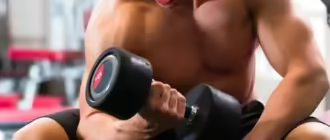In the last article, we covered in detail almost all the principles of training the abdominal muscles. Let us recall some aspects.
As you remember, two abdominal workouts per week will be more than enough. Do not use weights and watch your technique. There is no point in jerking through this or that exercise, even on the last repetition. It is much wiser to stop the set in time, rest, and competently perform a new working approach. Many girls, when performing various exercises, focus on the wrong movements. For example, in hanging leg raises you need to focus your attention not on the lifts themselves, but on the work of the rectus abdominis muscles. It sounds simple, but in practice it helps quite a lot. In general, when training any muscle group, it is important to think about it, at the time of performing the exercise, of course. This “mental” method helps to exclude from the work secondary synergistic muscles, with the help of which the movement ends.
Further, you should not perform the same exercises over and over again. It is advisable to alternate them each time. That is, if in the last abdominal training you performed double crunches and a side plank, then in the next training you are required to perform completely different movements, for example, a bicycle and hanging leg raises. As for repetitions and sets, the ideal would be one warm-up set and 4 working sets of 15-20 competent repetitions. The duration of rest between sets can vary from two to three minutes. Well, enough advice, let’s move on to the exercises themselves.
1. Double crunches.
One of the best exercises for the rectus abdominis muscle. Thanks to the special mechanics of double twists, the load is evenly distributed throughout the entire rectus abdominal muscle. It is advisable to do the training first, since the effort required is quite large.
Starting position:
Lie on the floor with your entire back. Bend your knees and lift them so that your thighs are perpendicular to the floor and your calves are parallel. You should raise your head a little and put your hands behind it, joining them in a so-called lock. Take a look at the drawing to better understand the placement of the legs and arms.
Execution:
Slowly and in a controlled manner, begin to twist your upper body, trying to reach your chest to your lower abdomen. At the same time, your knees should try to touch your face or head. Both movements begin simultaneously. Stay at the critical point for a couple of seconds, while trying to statically load your abdominal muscles as much as possible. This is followed by a return to the starting position of the same speed, in which the back of your head touches the floor. At the bottom, after a half-second pause, start a new repetition.
Recommendations:
Don’t pull your head with your hands, as you will only hurt your neck. It is very important to perform a twisting movement, and not a banal lifting of the body. Let me remind you that the crunch is a lift of only the upper body, the middle and lower back remain on the floor throughout the entire exercise.
2. Bicycle.
This exercise has a slightly similar mechanics to double crunches, but the main load here falls on the oblique abdominal muscles and the so-called serratus muscles. The expenditure of energy is just as great.
Starting position:
The starting position exactly copies double twists.
Execution:
With a powerful force, begin to pull opposite elbows and knees towards each other, as shown in the figure. In this case, the non-working leg should straighten and remain hanging in order to load the rectus abdominis muscle with a static load. Stay at the critical point for just a second and begin to pull your other elbow towards your other knee, straightening your non-working leg.
Recommendations:
As you can see, during the entire exercise you do not lower your upper body, this in turn loads the abdominal muscles with a constant static load. The elbow pull should be a lateral twist to the side. As in the previous exercise, you should not pull your head with your hands.
3. Hanging leg or knee raises.
Raising the legs specifically loads the rectus abdominis muscle, transferring most of the load to the lower section. To perform this you will need to be in a hanging position. This can be done both on the horizontal bar and on a special simulator, which is shown in the illustration. I would like to immediately note that you can perform lifts with both straight legs and bent ones, the load does not change, but the legs get tired. That’s why we’ll look at the knee raise option.
Starting position:
Take a hanging position. The body should be perpendicular to the floor. Relax your legs and lower them down.
Execution:
Raise your legs so that your thighs are parallel to the floor and your shins are perpendicular. Fix the angle at your knees and begin lifting your legs under control, without moving your body. They should be raised to a point slightly above the line parallel to the floor. Pause at the top, and only then very slowly lower your legs down, without changing the angle of your knees. At the bottom, without pausing, start a new repeat.
Recommendations:
The most important factor in the effectiveness of the exercise is the fixed angle in the knees. A stationary torso also plays an important role. Focus on working your abs rather than lifting your legs. It is this technique that will allow you to perform the exercise correctly.







